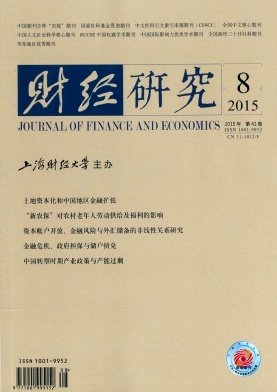中国转型时期产业政策与产能过剩——基于制造业面板数据的实证研究
财经研究 2015 年 第 41 卷第 08 期, 页码:
摘要
参考文献
摘要
产业政策是导致我国转型时期产能过剩产生的重要因素。文章利用中国1999-2011年制造业面板数据实证研究发现,产业政策对产能利用率的效应显著为负,不同政策工具对产能过剩的影响并不相同:(1)税负降低会带来产能利用率的下降,两者显著正相关;(2)贸易保护与产能利用率的关系显著为正,贸易保护程度的增强在短期内会提高产能利用率;(3)创新补贴与产能利用率之间的关系显著为负,政府补贴对创新效率具有负作用。进一步地,小企业、国有企业和行业低技术的比重越高,产业政策就越有可能造成产能过剩。因此,为了更有效地化解和防止产能过剩,我国的产业政策亟需转向竞争政策。
[1]程俊杰. 负面清单管理与转轨时期中国体制性产能过剩治理[J]. 学习与实践, 2014, (12):11-20.
[2]冯宗宪,王青,侯晓辉. 政府投入、市场化程度与中国工业企业的技术创新效率[J]. 数量经济技术经济研究, 2011, (4):3-17.
[3]付启敏, 刘伟. 不确定性条件下产能过剩的纵向一体化模型[J]. 系统管理学报, 2011, (2):188-195.
[4]韩国高,高铁梅,王立国等. 中国制造业产能过剩的测度、波动及成因研究[J]. 经济研究, 2011, (12):18-31.
[5]江飞涛, 耿强, 吕大国等. 地区竞争、体制扭曲与产能过剩的形成机理[J]. 中国工业经济, 2012, (6):44-56.
[6]林毅夫, 巫和懋, 邢亦青. “潮涌现象”与产能过剩的形成机制[J]. 经济研究, 2010, (10):4-19.
[7]刘小鲁. 地方政府主导型消耗战与制度性退出壁垒[J]. 世界经济, 2005, (9):33-41.
[8]沈坤荣, 钦晓双, 孙成浩. 中国产能过剩的成因与测度[J]. 产业经济评论, 2012, (4):1-26.
[9]生延超. 创新投入补贴还是创新产品补贴: 技术联盟的政府策略选择[J]. 中国管理科学, 2008, (6):184-192.
[10]孙巍, 何彬, 武治国. 现阶段工业产能过剩“窖藏效应”的数理分析及其实证检验[J]. 吉林大学社会科学学报, 2008, (1):68-75.
[11]王立国, 鞠蕾. 地方政府干预、企业过度投资与产能过剩:26个行业样本[J]. 改革, 2012, (12):52-62.
[12]Blonigen B A,Wilson W W. Foreign subsidization and excess capacity[J]. Journal of International Economics, 2010,80(2):200-211.
[13]Chen T,Ku Y H. Indigenous innovation vs. tenglong huanniao: Policy conflicts in the development of China’s flat panel industry[J]. Industrial and Corporate Change, 2014,2(1):1-23.
[14]Goolsbee A. Does government R&D policy mainly benefit scientists and engineers?[J]. American Economic Review,1998,88(2):298-302.
[15]Ishii J. Useful excess capacity? An empirical study of U.S. oil & gas drilling[R].Amherst College Working Paper, 2011.
[16]Janeba E. Tax competition when governments lack commitment: Excess capacity as a countervailing threat[J]. American Economic Review, 2000,90(5):1508-1519.
[17]Mann M,Meehan J W,Ramsay G A. Market structure and excess capacity: A look at theory and some evidence[J]. Review of Economics and Statistics, 1979,61(1):156-159.
[18]Sahay R. Trade policy and excess capacity in developing countries[J]. Staff PapersInternational Monetary Fund, 1990,37(3):486-508.
[19]Schwartz E. “Excess capacity” in utility industries: An inventory theoretic approach[J]. Land Economics, 1984,60(1):40-48.
[20]Shaikh A,Moudud J. Measuring capacity utilization in OECD countries: A cointegration method[R]. The Levy Economics Institute of Bard College, Working Paper No.415, 2004.
[21]Staiger R W, Wolak F A. The effect of domestic antidumping law in the presence of foreign monopoly[J]. Journal of International Economics , 1992,32(3-4):265-287.
[22]Steel W F. Import substitution and excess capacity in Ghana[J]. Oxford Economic Papers, 1972,24(2):212-240.
[2]冯宗宪,王青,侯晓辉. 政府投入、市场化程度与中国工业企业的技术创新效率[J]. 数量经济技术经济研究, 2011, (4):3-17.
[3]付启敏, 刘伟. 不确定性条件下产能过剩的纵向一体化模型[J]. 系统管理学报, 2011, (2):188-195.
[4]韩国高,高铁梅,王立国等. 中国制造业产能过剩的测度、波动及成因研究[J]. 经济研究, 2011, (12):18-31.
[5]江飞涛, 耿强, 吕大国等. 地区竞争、体制扭曲与产能过剩的形成机理[J]. 中国工业经济, 2012, (6):44-56.
[6]林毅夫, 巫和懋, 邢亦青. “潮涌现象”与产能过剩的形成机制[J]. 经济研究, 2010, (10):4-19.
[7]刘小鲁. 地方政府主导型消耗战与制度性退出壁垒[J]. 世界经济, 2005, (9):33-41.
[8]沈坤荣, 钦晓双, 孙成浩. 中国产能过剩的成因与测度[J]. 产业经济评论, 2012, (4):1-26.
[9]生延超. 创新投入补贴还是创新产品补贴: 技术联盟的政府策略选择[J]. 中国管理科学, 2008, (6):184-192.
[10]孙巍, 何彬, 武治国. 现阶段工业产能过剩“窖藏效应”的数理分析及其实证检验[J]. 吉林大学社会科学学报, 2008, (1):68-75.
[11]王立国, 鞠蕾. 地方政府干预、企业过度投资与产能过剩:26个行业样本[J]. 改革, 2012, (12):52-62.
[12]Blonigen B A,Wilson W W. Foreign subsidization and excess capacity[J]. Journal of International Economics, 2010,80(2):200-211.
[13]Chen T,Ku Y H. Indigenous innovation vs. tenglong huanniao: Policy conflicts in the development of China’s flat panel industry[J]. Industrial and Corporate Change, 2014,2(1):1-23.
[14]Goolsbee A. Does government R&D policy mainly benefit scientists and engineers?[J]. American Economic Review,1998,88(2):298-302.
[15]Ishii J. Useful excess capacity? An empirical study of U.S. oil & gas drilling[R].Amherst College Working Paper, 2011.
[16]Janeba E. Tax competition when governments lack commitment: Excess capacity as a countervailing threat[J]. American Economic Review, 2000,90(5):1508-1519.
[17]Mann M,Meehan J W,Ramsay G A. Market structure and excess capacity: A look at theory and some evidence[J]. Review of Economics and Statistics, 1979,61(1):156-159.
[18]Sahay R. Trade policy and excess capacity in developing countries[J]. Staff PapersInternational Monetary Fund, 1990,37(3):486-508.
[19]Schwartz E. “Excess capacity” in utility industries: An inventory theoretic approach[J]. Land Economics, 1984,60(1):40-48.
[20]Shaikh A,Moudud J. Measuring capacity utilization in OECD countries: A cointegration method[R]. The Levy Economics Institute of Bard College, Working Paper No.415, 2004.
[21]Staiger R W, Wolak F A. The effect of domestic antidumping law in the presence of foreign monopoly[J]. Journal of International Economics , 1992,32(3-4):265-287.
[22]Steel W F. Import substitution and excess capacity in Ghana[J]. Oxford Economic Papers, 1972,24(2):212-240.
引用本文
程俊杰. 中国转型时期产业政策与产能过剩——基于制造业面板数据的实证研究[J]. 财经研究, 2015, 41(8): 0.
导出参考文献,格式为:





 8376
8376  6138
6138

